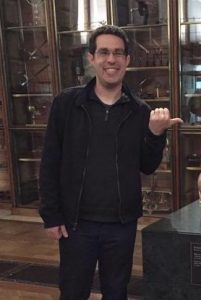We’re thrilled to provide an opportunity for Dr Erin Bartram and Dr Chris Bouton to discuss the origins of and promote their new project The Daily Context. These sorts of projects are critical to improving historical literacy and knowledge.
 Dr Erin Bartram is a Visiting Assistant Professor in the History Department at the University of Hartford. She earned my PhD from the University of Connecticut in December 2015, with a dissertation on women who converted to Catholicism at the height of the 19th century anti-Catholic movement in America. Erin is currently working on a book on women and self-culture in 19th century America. She is also keenly interested in pedagogy, and write about it frequently over at my own blog. She drinks tea, sing alto, and is a proud Nutmegger. Erin can also be found on Twitter.
Dr Erin Bartram is a Visiting Assistant Professor in the History Department at the University of Hartford. She earned my PhD from the University of Connecticut in December 2015, with a dissertation on women who converted to Catholicism at the height of the 19th century anti-Catholic movement in America. Erin is currently working on a book on women and self-culture in 19th century America. She is also keenly interested in pedagogy, and write about it frequently over at my own blog. She drinks tea, sing alto, and is a proud Nutmegger. Erin can also be found on Twitter.
 Dr Chris Bouton earned his PhD from the University of Delaware in May 2016. His dissertation investigated physical confrontations between slaves and whites in Antebellum Virginia. Chris’s general research interests include the history of American slavery, violence, and abolitionism. Outside of academia, he roots for Boston sports teams and have interests in sabermetrics, cooking, and playing with his dog Mayday and bunny Hillary. Chris can also be found on Twitter.
Dr Chris Bouton earned his PhD from the University of Delaware in May 2016. His dissertation investigated physical confrontations between slaves and whites in Antebellum Virginia. Chris’s general research interests include the history of American slavery, violence, and abolitionism. Outside of academia, he roots for Boston sports teams and have interests in sabermetrics, cooking, and playing with his dog Mayday and bunny Hillary. Chris can also be found on Twitter.
The origin of this project was the election of Donald Trump as president of the United States and his casual relationship with the truth and critical thinking. We both participated in the Women’s March (at different ones) and we had the desire to try and contextualize what we’re seeing unfold at this remarkable moment in American history. We have a deeply anti-intellectual president who constantly lies to manipulate facts, the media, and even history itself to serve his own personal ends. Moreover, as so many historians pointed out during the campaign, Trump has been making an explicit historical claim with his campaign slogan, arguing that America was great at some point in the past, and he will make it so again. In responding to all of this, we wanted to do something that would appeal to – and speak to – the broader public, and not just fellow academics. For example, we as historians know the anti-Semitic origins of the phrase “America First.” The broader public doesn’t, so maybe we can find a way to share that information.
So the question became, how should we go about accomplishing this? The news cycle moves so quickly now that we wanted to be as reactive as possible. Being reactive meant doing shorter pieces that required less time to write and edit. Additionally, we wanted to make something manageable for ourselves. This blog doesn’t pay and it isn’t our jobs. With all that in mind, we capped the word count at one thousand. We decided to include images, political cartoons, and other materials to engage readers. At the end of each post, we provide links to primary and secondary sources so that if readers are interested in learning more they have a place to go. There are plenty of places engaged readers can go for big picture pieces by prominent scholars in their fields, like The Atlantic, Slate, or elsewhere. There are plenty of historians doing their own work online. Those places are all great and fill important niches in the ways that historians are attempting to reach out to the broader public. But we also believe that there’s a market, we think, for these shorter pieces that can serve as an entry point for a more critical examination of contemporary events. So we set up a blog on wordpress and then made up a Twitter and Facebook page, as most people now get their news filtered through social media.
In terms of audience and writing, we’ve both articulated the idea that this blog could be something that our parents or friends could read and get a better understanding of what’s going on. We believe that engaging the broader public is crucial and we have to meet them on their terms. Kurt Vonnegut has that great line about taking pity on your reader because reading is really difficult without the writer trying to complicate things too much. Most people don’t want to read a three or four thousand word think-piece. They want something that is engaging and understandable, but won’t take an hour to read. Being able to offer historical context in a cogent manner without compromising its integrity is difficult. Especially since as a profession historians are geared towards these formats—articles, dissertations, and books—that all have to be a certain length. And we get to fill them with all the awesome detail and context that we love. When we write shorter pieces, we have to boil these issues, like the origins of “America First” or the Chinese Exclusion Act, to their essence. That’s really difficult to do, but it’s worth the effort to try and keep our fellow citizens informed about what has happened in history and how that’s related to what’s happening now.







